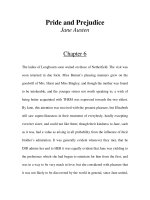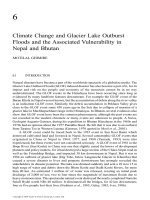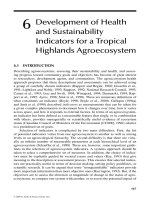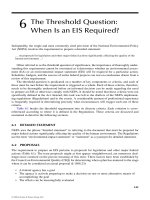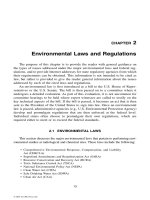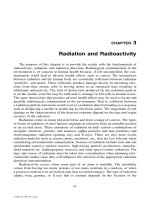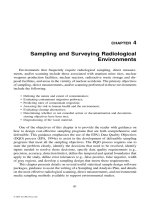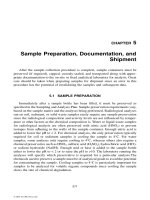Air Sampling and Industrial Hygiene Engineering - Chapter 6 ppt
Bạn đang xem bản rút gọn của tài liệu. Xem và tải ngay bản đầy đủ của tài liệu tại đây (101.91 KB, 15 trang )
CHAPTER 6
Biological Risk Assessment
Given that many of the indoor air problems (whether on remediation sites or elsewhere) are
caused by biological contaminants and their decomposition products, Chapter 6 provides real-world
examples of biological monitoring protocols.
All sampling for biologicals must take into account surrounding environmental factors
and building usage. Drawing a complete history and in some cases additional types of air
sampling for other contaminants are required. In discussing sampling for biologicals we
will also discuss the reasons for concern and control mechanisms that can be used.
You must always remember that biologicals, unlike chemical contaminants, have the
potential to reproduce and thus grow in numbers. Care must be taken to sample in a con-
sistent fashion in as short a period as possible.
Reproduction of biologicals also calls into question the relative viability of spores and
bacterial colonies that are encysted. In cases where amplification is primarily bacterial,
these colonies may inhibit spores from developing into vegetative structures. Conse-
quently comparative levels for bacterial counts and mold colony forming units (CFUs) may
be required, especially since spores in and of themselves can be problematic. Thus, the
absence of visible mold growth may not be indicative of a clean environment.
When molds are amplified to the extent that the building is increasingly hospitable to
further mold growth, we may begin to see pathogenic colonies (that would not otherwise
be present) taking hold in a building’s interior. All of us exhibit great concern when con-
fronted with possible Stachybotrys atra (Stachy). Airstream movement does not readily
spread Stachy, as the spores become less viable in dry airstream environments. However,
in moisture-laden airstreams or within homes with other amplified mold colonies, Stachy
may begin to flourish.
In areas where bird or other animal droppings are prevalent, we begin to be concerned
about histoplasmosis and coccidiomycosis. Histoplasma (Histo) is the more likely disease
vector where other molds are flourishing, given that Histo is better able to survive in wet-
ter environments.
Keep in mind that the term wet is a relative one. Some of these molds do not need “wet’’
environments in the traditional sense to grow well; any condensation will do, even that
caused by very slight temperature differences.
The old way of thinking that fiberglass will not grow biologicals is also not correct. The
fiberglass itself may not be a good food source; however, the fiberglass forms a nice nest
and traps other food sources. Fiberglass filters, lined fiberglass ducts, and fiberglass panels
© 2001 CRC Press LLC
Figure 6.1 Biological contact agar strips. (Biotest Diagnostic Corp.)
inserted for insulation all become less densely packed with age and use. Particulates, espe-
cially those associated with any greasy, vapor-laden airstream, stick to the fiberglass and
provide a nutrient bed for biological contamination.
Because of the problems with grease or oil in airstreams and biological amplification,
care must be taken in using these products. Whenever refrigerant lines bearing mineral oil
and freon are serviced, any breakage should be viewed as potentially providing a nutrient
“fly paper’’ for biological contaminants.
So—how much is bad? This is determined in part by aesthetic concerns and in part by
health concerns. If you do not want visible mold growth, even small colonies may be too
much. Larger colonies, even if no health effects are forthcoming, are certainly unacceptable
and over time may even do structural damage. Aspergilluscan thrive on cellulose, paint,
and drywall, leaving unpleasant looking stains as the colonies die. The health questions
have many answers depending in part on how sampling is accomplished. With current
sampling protocols we become concerned if any part of a building is showing amplified
mold growth. We often compare to exterior background levels or to levels in a part of the
building shown to be relatively free of mold contamination. In the sense that these biolog-
ical contaminants may be ever changing in numbers as conditions change, there is no such
thing as a static background level. The lack of “hard numbers’’ is one other reason that the
sampling team and microbiologist oversight must include senior level scientists.
For sensitized individuals, the elderly or very young and immune-compromised
people, even very sparse mold colonies may cause health problems. Certainly anyone hos-
pitalized for surgery or other invasive medical procedures would also be considered
immune compromised during that interval of time. For individuals without these types of
concerns, we want to see nonpathogenic mold counts less than 200 CFU/m
3
over estab-
lished background levels. Higher levels may be acceptable for certain mixes of mold
species, and lower levels are required for single species and pathogenic contaminant
confidence.
Contact samples should always be less than 200 CFU/strip for areas to be judged
“clean.’’ Acombination of contact and air-sampling information is required to assess most
buildings (Figure 6.1), and these acceptable numbers vary given different biological con-
taminant mixes and building usage. For example, in a hospital setting, 20 CFU/strip would
be too much in the operating room and perfectly acceptable in the visitor’s waiting room.
Once the level of contamination is assessed, we can begin to decide how to remedy any
negative situations. Steam cleaning without the use of biocides is sometimes the wrong
thing to do. Remember that even steam cools, and cool water is just what most molds need
© 2001 CRC Press LLC
to increase their amplification rate. Steam cleaning can be beneficial with adequate drying
cycles and in some instances the concurrent use of biocides.
Biocide usage can also be problematic. Chemicals that work in the laboratory may
cause aesthetic and even health problems in the real world. Biocides often have limited
residual time and may not even be tested against the particular biological contaminant mix
of concern.
Residual time for any chemical mix has many unresolved questions; sometimes the
chemicals’ residual time in your particular circumstances is not even known. In other cases
residual time may make the chemical unattractive because the toxic properties of the chem-
ical remain and can cause contamination problems in and of themselves. We must always
remember that the basic cellular structure of these biological contaminants and ourselves
is the same, so chemicals that harm these contaminants may also harm us.
Recently, biocides with FDA and EPA approval have been developed and can be used
in areas where biocides were formerly unacceptable. The decision in selecting the appro-
priate biocide that will not harm humans, animal occupants, or damage structural materi-
als can be a difficult one. Decontamination and rehabitation methodologies must be part of
a coordinated remedial design effort.
One of the more common replies to all of this information is—why now? The answer
is twofold; first, we probably always had these concerns once we lived for any length of
time indoors; second, we have increasingly closed our buildings and relied on forced air
ventilation systems. Both of these answers are also applicable to closed cab modes of trans-
portation—airplanes, automobiles, rail cars, and ships.
In the past we thought that endpoint filtration of airstreams was sufficient to render
delivered air relatively pure. We have now learned that filtration only works for a time, and
excessive biological amplification can be transmitted through most current HVAC systems
once established in ductwork or plenums.
If you suspect biological contamination, see visible mold growth, have personnel with
repetitive mycosial infections, or have indoor air quality (IAQ) problems that have
remained undiagnosed, you need to consult a team of professionals to find answers to
these problems. In these cases not only is the mold growth itself problematic, but also we
have to worry about the chemicals formed as colonies die. Dieback causes the chemicals
formed during decomposition to be spread throughout building, and these are the same
VOCs we worry about from chemical spills or misuse. The following sections speak
directly to hazards associated with mold and fungi.
6.1 FUNGI, MOLDS, AND RISK
When inhaled, microscopic fungal spores or fragments of fungi may cause allergic
rhinitis. Because they are so small, mold spores may evade the protective mechanisms of
the nose and upper respiratory tract to reach the lungs and bring on asthma symptoms. The
buildup of mucus, wheezing, and difficulty in breathing are the result. Less frequently,
exposure to spores or fragments may lead to a lung disease known as hypersensitivity
pneumonitis.
Molds are present in our exterior environments, and, hopefully, to a lesser extent in our
interior environments. People allergic to molds may have allergic symptoms from spring
to late fall. The mold season often peaks from July to late summer. Unlike pollens, molds
may persist after the first killing frost. Some can grow at subfreezing temperatures, but
most become dormant. Snow cover lowers the outdoor mold count drastically, but does not
kill molds. After the spring thaw, molds thrive on the vegetation that has been killed by the
© 2001 CRC Press LLC
winter cold. In the warmest areas of the world, however, molds thrive year-round and can
cause perennial allergic problems. Molds growing indoors can cause perennial allergic
rhinitis even in the coldest climates.
If indoor areas show signs of amplification identified by visual assessment, air sam-
pling, and contact/liquid sampling, amplification must be suspected. Amplification is the
process whereby biological organisms continue to increase over time. If this increase is not
controlled, sufficient mold spores and vegetative structures may be present to create indoor
air problems.
Hot spots of mold growth in the home include damp basements and closets, bathrooms
(especially shower stalls), places where fresh food is stored, refrigerator drip trays, house
plants, air conditioners, humidifiers, garbage pails, mattresses, upholstered furniture, and
old foam rubber pillows.
6.1.1 What Is the Difference between Molds, Fungi, and Yeasts?
Molds and yeasts are two groups of plants in the fungus family. Yeasts are single cells
that divide to form clusters. Molds consist of many cells that grow as branching threads
called hyphae. The seeds or reproductive particles of fungi are called spores. They differ in
size, shape, and color among species. Each spore that germinates can give rise to new mold
growth, which in turn can produce millions of spores.
6.1.2 How Would I Become Exposed to Fungi That Would Create a
Health Effect?
The route of exposure may be inhalation or ingestion accompanied by inhalation.
When inhaled, microscopic fungal spores or fragments of fungi may cause health prob-
lems. Because they are so small, mold spores may evade the protective mechanisms of the
nose and upper respiratory tract to reach the lungs and bring on asthma symptoms. The
buildup of mucus, wheezing, and difficulty in breathing are the result. Less frequently,
exposure to spores or fragments may lead to a lung disease known as hypersensitivity
pneumonitis.
6.1.3 What Types of Molds Are Commonly Found Indoors?
In general, Alternaria and Cladosporium (Hormodendrum) are the molds most commonly
found both indoors and outdoors throughout the U.S. Aspergillus, Penicillium, Helmintho-
sporium, Epicoccum, Fusarium, Mucor, Rhizopus, and Aureobasidium (Pullularia) are also
common.
6.1.4 Are Mold Counts Helpful?
Similar to pollen counts, mold counts may suggest the types and relative quantities of
mold present at a certain time and place. For several reasons, however, these counts prob-
ably cannot be used as a constant guide for daily activities. One reason is that the number
and types of spores actually present in the mold count may have changed considerably in
24 h because weather and spore dispersal are directly related. Many of the common aller-
genic molds are of the dry spore type—they release their spores during dry, windy weather.
© 2001 CRC Press LLC
Other molds need high humidity, fog, or dew to release their spores. Although rain washes
many larger spores out of the air, it also releases some smaller spores into the air.
6.1.5 What Can Happen with Mold-Caused Health Disorders?
Fungi or microorganisms related to them may cause other health problems similar to
an allergy. Fungi may lodge in the airways or a distant part of the lung and grow until they
form a compact sphere known as a “fungus ball.’’ In people with lung damage or serious
underlying illnesses, Aspergillus may grasp the opportunity to invade and actually infect
the lungs or the whole body. In some individuals exposure to these fungi can also lead to
asthma or to an illness known as “allergic bronchopulmonary aspergillosis.’’ This latter
condition, which occurs occasionally in people with asthma, is characterized by wheezing,
low-grade fever, and coughing up of brown-flecked masses or mucous plugs. Skin testing,
blood tests, X-rays, and examination of the sputum for fungi can help establish the diag-
nosis. The occurrence of allergic aspergillosis suggests that other fungi might cause similar
respiratory conditions.
Inhalation of spores from fungus-like bacteria, called actinomycetes, and from molds
can cause a lung disease called hypersensitivity pneumonitis. This condition is often asso-
ciated with specific occupations. Hypersensitivity pneumonitis develops in people who
live or work where an air-conditioning or a humidifying unit is contaminated with and
emits these spores. The symptoms of hypersensitivity pneumonitis may resemble those of
a bacterial or viral infection such as the flu. If hypersensitivity pneumonitis is allowed to
progress, it can lead to serious heart and lung problems.
6.2 BIOLOGICAL AGENTS AND FUNGI TYPES
A host of fungi are commonly found in ventilation systems and indoor environments.
The main hazardous species belong to the following genera: Absidia, Alternaria, Aspergillus,
Fusarium, Cladosporium, Cryptostroma, Mucor, Penicillium, and Stachybotrys. Various strains
of these genera of molds have been implicated in being causative agents in asthma, hyper-
sensitivity pneumonitis, and pulmonary mycosis.
Fungi commonly found in ventilation systems and indoor environments include
Absidia, Acremonium, Alternaria, Aspergillus, Aureobasidium, Botrytis, Cephalosporium,
Chrysosporium, Cladosporium, Epicoccum, Fusarium, Helminthosporium, Mucor, Nigrospora,
Penicillium, Phoma, Pithomyces, Rhinocladiella, Rhizopus, Scopulariopsis, Stachybotrys,
Streptomyces, Stysanus, Ulocladium, Yeast, and Zygosporium. Eleven types of fungi are typi-
cally found in homes: Aspergillus, Cladosporium, Chrysosporium, Epicoccum, Fonsecaea,
Penicillium, Stachybotrys, and Trichoderma.
6.2.1 Alternaria
A number of very similar, related species are usually grouped together as Alternaria.
The spores of Alternaria are multicelled and developed in chains, head-to-toe, from which
their name derives. Spores are multiseptate, both transverse and longitudinally. They vary
in width and length according to species, usually 8–75 m long; some species such as A.
longissima are up to 0.5 mm long. Alternaria, which is both ubiquitous and abundant, is both
saprophytic and parasitic on plant material and is found on rotting vegetation as well as in
damp indoor areas, such as bathrooms. Some species of Alternaria are the imperfect, asex-
ual, anamorph spores of the ascomycete Pleospora.
© 2001 CRC Press LLC
6.2.2 Aureobasidium
Aureobasidium is common in both outdoor and indoor air, bathroom walls, and shower
curtains. Aureobasidium causes mildew and has been isolated in flooded areas of buildings,
as well as from soils, plants, and other substrates. Aureobasidium has been associated with
hypersensitivity pneumonitis in some individuals.
6.2.3 Cladosporium
Cladosporium, composed of over 500 species, is found in outdoor as well as indoor air.
Cladosporium has been isolated from fuels, wood, plant tissues, straw, face cream, air, soil,
foods, paint, and textiles. Cladosporium spores are often found in higher concentrations in
the air than any other fungal spore type.
Cladosporium bears copious numbers of spores on branched conidiophores. The spores
usually have distinctive “scars’’ at both ends where they are joined both to the spore at one
end and to the conidiophore at the other. Although often identified as single-celled spores,
spores are frequently seen with a single transverse septum or several transverse septa.
Their length ranges from 4 to 20 m.
Cladosporium (Hormodendrum) is the most commonly identified outdoor fungus and is
a common indoor air allergen. Indoors Cladosporium may be different from the species
identified outdoors. Cladosporium is commonly found on the surface of fiberglass duct lin-
ers in the interior of supply ducts. Cladosporium can cause mycosis and is a common cause
of extrinsic asthma (immediate-type hypersensitivity: type I). Acute symptoms include
edema and bronchiospasms; chronic cases may develop pulmonary emphysema.
6.2.4 Rhodotorula
Rhodotorula is a commonly isolated yeast that is frequently isolated from humidifiers
and soil. Rhodotorula may be allergenic to susceptible individuals when present in sufficient
concentrations.
6.2.5 Stemphylium
Stemphylium is a saprophytic fungus (grows on nonliving organic material) commonly
found on cellulosic materials (that is, of plant origin, including livestock feed, cotton cloth,
ceiling tiles, paper). Stemphylium is an example of a diurnal sporulator. An alternating light
and dark cycle is required for spore development. This fungus requires ultraviolet light for
the production of conidiophores; however, the second developmental phase, when the
conidia are produced, requires a dark period. Stemphylium also requires wet conditions for
growth. Stemphylium spores range from 23 to 75 m in length.
6.2.6 Sterile Fungi
Sterile fungi are common to both outdoor and indoor air. These fungi produce vegeta-
tive growth, but yield no spores for identification. Their presence will increase CFU/l.
Derived from ascospores or basidiospores, the spores of which are likely to be allergenic,
these fungi should be considered allergenic.
© 2001 CRC Press LLC
6.2.7 Yeast
Various yeasts are commonly identified on air samples. Yeasts are not known to be
allergenic, but they may cause problems if a person has had previous exposure and devel-
oped hypersensitivities. Yeasts may be allergenic to susceptible individuals when present
in sufficient concentrations. Yeast grows when moisture, food, and just the right tempera-
tures are available.
6.3 ASPERGILLUS
Aspergillus and Penicillium are molds prevalent in soils. These molds can cause asthma-
like symptoms or other lung irritation in humans and deterioration in buildings and other
materials. When conditions within buildings cause the buildup of moisture on surfaces and
temperatures are right, Aspergillus grows well and is evidenced by a black deposit.
Aspergillus is a type of mold called Ascomycota or sac fungi. Sac fungi have sexual
spores that are produced in an ascus or saclike structure. Their asexual spores, called coni-
diospores (from the word conidia, which means “dust’’), are produced in long chains from
a conidiophore. The characteristic arrangement of the conidiospores is used to identify the
different molds. Penicillium is another mold that is also called Ascomycetes.
6.3.1 What Color Are These Molds?
Aspergillus is black, and Penicillium is white. Also, Aspergillus is not the black mold on
bread. That mold is
Rhizopus nigricans. The difference is evident in the differing structures
for black asexual spores (sporangiospores).
6.3.2 How Is Aspergillus Spread?
Aspergillus spores are carried in the wind and through ventilation airstreams in homes.
The asexual spores freely detach from the conidiophore chain and, with the slightest dis-
turbance, float in the air like dust. The easiest way to get Aspergillus started in the home is
to bring the spores in on shoes and deposit the spores on carpet fibers.
6.3.3 How Does Aspergillus Grow/Amplify?
When the spores are placed on wet surfaces, the spores grow hyphae. The hyphae
grow, form a mass, and are soon visible to the naked eye. The vegetative mycelium process
foods, and reproductive mycelium create more spores. At this time the mold/fungi
appears as a black fuzzy mass. (Amplification is the process whereby Aspergillus or other
biological organisms continue to increase in number over time.)
6.3.4 What Conditions Help Aspergillus Grow/Amplify?
Fungi generally grow better with an acidic pH. The growth is usually on the surface
rather than embedded within a substrate (under the surface).
Fungi are able to grow on surfaces with a low moisture content, in contrast to the mois-
ture required for bacterial growth. Therefore, even a slight difference in temperature and
surface moisture facilitates the growth of fungi.
© 2001 CRC Press LLC
Fungi are capable of using complex carbohydrates, such as lignin (wood). Thus, with
a little moisture, fungi can easily grow on wood or other complex organic materials. These
adaptations allow fungi to grow readily on painted walls and shoe leather.
6.3.5 Can Mold/Fungi Make You Sick?
Fungal diseases are called mycoses, which are chronic, long-lasting infections.
Aspergillosis is an opportunistic infection that can become pathogenic (disease-causing) in
a weakened individual host. The inhalation of spores is a possible mode of entry into the
body as spore size ranges from 2 to 10 m.
6.3.6 What Are the Symptoms of Aspergillosis?
The incubation period varies with different individuals. People with other weakening
medical problems or general ill health are most susceptible. Aspergillus niger (A. niger) pro-
duces mycotoxins that can induce asthma-like symptoms. In situations when A. niger was
found growing with Penicillium sp., massive inhalation of spores has been documented as
causing an acute, diffuse, self-limiting pneumonitis (lung irritation). Healthy individuals
can exhibit otitis externa (inflammation of the outer ear canal) as a result of Aspergillus
growth.
6.3.7 Does Aspergillus Cause Deterioration of Materials?
Members of the Aspergillus genus are known as biodeteriogens (organisms that cause
deterioration of materials). A. niger causes damage, discoloration, and softening of the sur-
faces of woods, even in the presence of wood preservatives. A. niger also causes damage to
cellulose materials, hides, and cotton fibers. A. niger can also attack plastics and polymers
(i.e., cellulose nitrate, polyvinyl acetate, polyester type polyurethanes).
6.3.8 What Happens If Aspergillus Colonies Grow inside
Construction Layers?
In cases of extensive growth, colonies will grow into wood, plaster, and/or dry-
wall, causing a soft bulging area. This area lacks structural integrity and is subject to early
deterioration.
6.3.9 How Is Aspergillus Identified?
Soy agar will grow Aspergillus and a wide range of other microbiologicals. Thus,
Tryptic Soy Agar or Potato Dextrose Agar is the original screening tool used to determine
the presence of biologicals. Once biological contamination has been established, selective
media can be used to grow suspect organisms for identification. Using a special type of pro-
tein gelatin (called Rose Bengal Agar) that has been made with special nutrients, Aspergillus
cultures can be selectively and quickly grown.
© 2001 CRC Press LLC
6.3.10 How Are Levels of Aspergillus Communicated?
Aspergillus is reported in terms of colony forming units per cubic meter. The presence
of any one fungi in excess of 200 CFU/m
3
is indicative of an indoor source of fungal
amplification. The presence of any colony forming units per cubic meter is indicative of
transmission of fungal spores from surface to surface and/or from exterior to interior
locations.
6.3.11 Why Do Aspergillus Colonies Look Black?
Aspergillus is black or brown-black. Also, active biological contamination creates a sur-
face to which dusts and other debris “stick.’’ If biological contamination is extensive and
characterized by amplification and “kill’’ cycle condition, the fungi/molds will decay and
produce toxins. These toxins can be identified with Aspergillus contamination as a black
stain or tarlike liquid residue.
6.3.12 What Will Biotesting of the Air Show?
Biotesting using a BIOTEST air monitor will reveal whether colony forming units are
found in the air. Biotesting by surface culturing on agar reveals the presence of biologicals
on surfaces and in waters.
6.3.13 What Can Be Done to Prevent Aspergillus Growth?
Keep the air dry, provide filtered replacement air, and have sufficient air exchanges.
Prevent accumulation of standing water or leaks.
6.4 PENICILLIUM
Penicillium is a very large group of fungi valued as a producer of antibiotics. Penicillium
is commonly found in the soil; in the air; on living vegetation, seeds, grains, and animals;
and on wet insulation. Penicillium has been associated with hypersensitivity pneumonitis
in some individuals when it is present in high concentrations.
Penicillium is a source of antibiotic lines that have aided humanity. However, not all
species of Penicillium are helpful. Some can cause allergic reactions and other adverse
health effects when dispersed through indoor air. Currently, more and more is being
learned about the effects of Penicillium and other microbiologicals in indoor air. This sec-
tion represents a starting discussion of the risks associated with the growth of Penicillium
within indoor air environments.
Penicillium is a fungus that grows when moisture, food, and just the right temperatures
are available. Penicillium’s spherical spores are produced in long, unbranched chains of
each conidiophore. These usually fragment into individual spores, although chains of
spores are seen periodically on slides. Although some species of Penicillium appear to
reproduce solely by asexual means, some species of Penicillium are the anamorph (asexual)
stage of the ascomycete genus Talaromyces.
© 2001 CRC Press LLC
6.4.1 What Do Samples Look Like?
When samples are freshly prepared from culture, the spores are pale green, although
this fades with age. Their size ranges from 3 to 5 m. When using visual methods of iden-
tification, Aspergillus and Penicillium cannot be differentiated because the spores are so sim-
ilar that they are grouped together into the Aspergillus/Penicillium group. Spores from this
group are found almost all year-round.
6.4.2 What Species of Penicillium Are Used to Produce Antibiotics?
Penicillin, as produced by Alexander Fleming in 1929, was a product of Penicillium
notatum. Since that time, other species of Penicillium have been used to form other antibi-
otics. As an example, Griseofulvin is an antifungal antibiotic formed from a species of
Penicillium.
6.4.3 What Other Fungi Grow Where Penicillium Grows?
Aspergillus, Penicillium, Verticillium, Alternaria, and Fusarium are all found in the order
Moniliales and have similar morphology. Thus, where Aspergillus is found, one may expect
to find Penicillium and vice versa. The key here is the relative presence of moisture that may
accelerate the growth of one particular fungus rather than another.
6.4.4 If Penicillium Grows Everywhere, What Is the Concern?
The concern is that, in most cases, we do not want Penicillium growing inside us. This
warning is especially true if an individual is immune compromised.
People sensitized to Penicillium, the very young, the aging population, and people with
certain illnesses, could be considered immune compromised. These individuals may react
more strongly (and often more negatively) to some Penicillium species entering their
bodies.
6.4.5 How Does Penicillium Enter the Body?
The route of entry into the body is unknown. However, the respiratory route is used by
many other fungi with abundant conidia. Penicillium may have abundant conidia; thus, the
respiratory route of entry is expected. Skin trauma has been associated with local infection,
but not with systemic disease. Infection via the digestive route is unusual for filamentous
fungi.
6.4.6 Are There Particular Species of Penicillium about Which I
Should Be Concerned?
Within current medical literature, the primary concern is with Penicillium marneffei
(P. marneffei). This species has two life formations and is the only Penicillium species that
is termed dimorphic. The prevalence of one form over another is dependent on temper-
ature. At 37°C the fungus grows as yeasts forming white-to-tan, soft, or convoluted
colonies. Microscopically, the yeasts are spherical or oval and divide by fission rather than
budding.
© 2001 CRC Press LLC
At 25°C the fungus produces a fast-growing, grayish floccose colony. Microscopic
examination reveals septate branching hyphae with lateral and terminal conidiophores
that produce unbranched, broomlike chains of oval conidia.
Inside the body P. marneffei first proliferates in the reticuloendothelial system and then
is disseminated. The lungs and liver are usually the most severely involved organs. Other
commonly involved organs include skin, bone marrow, intestine, spleen, kidney, lymph
nodes, and tonsils.
The reticuloendothelial system is made up of special cells called phagocytes located
throughout the body; they can be found in the liver, spleen, bone marrow, brain, spinal
cord, and lungs. When functioning correctly, phagocytes destroy disease-causing organ-
isms by ingesting the organisms. An example of these cells are histiocytes. Histiocytes try
to ingest and kill P. marneffei. Unfortunately when the P. marneffei do not die, the histiocytes
carry them throughout the body.
6.5 FUNGI AND DISEASE
The main hazardous species belong to the following genera: Absidia, Alternaria,
Aspergillus, Fusarium, Cladosporium, Cryptostroma, Mucor, Penicillium, and Stachybotrys.
Various strains of these genera of molds have been implicated in being causative agents in
asthma, hypersensitivity pneumonitis, and pulmonary mycosis. Fungi commonly found in
ventilation systems and indoor environments include Absidia, Acremonium, Alternaria,
Aspergillus, Aureobasidium, Botrytis, Cephalosporium, Chrysosporium, Cladosporium, Epicoc-
cum, Fusarium, Helminthosporium, Mucor, Nigrospora, Penicillium, Phoma, Pithomyces,
Rhinocladiella, Rhizopus, Scopulariopsis, Stachybotrys, Streptomyces, Stysanus, Ulocladium,
Yeast, and Zygosporium.
6.5.1 Blastomyces dermatitidis
Local infections have occurred following accidental parenteral inoculation with
infected tissues or cultures containing yeast forms of B. dermatitidis. Parenteral (subcuta-
neous) inoculation of these materials may cause local granulomas.
Pulmonary infections have occurred following the presumed inhalation of conidia;
two individuals developed pneumonia and one had an osteolytic lesion from which B. der-
matitidis was cultured. Presumably, pulmonary infections are associated only with sporu-
lating mold forms (conidia).
6.5.2 Coccidioides immitis
Clinical disease may occur in 90% of an exposed indoor population. Infections
acquired in nature are asymptomatic in 50% of these outdoor cases. Because of their size
(2–5 nm), the arthroconidia are conducive to ready dispersal in air and retention in deep
pulmonary spaces. The much larger size of the spherule (30–60 nm) considerably reduces
the effectiveness of this form of the fungus as an airborne pathogen. Spherules of the fun-
gus may be present in clinical specimens and animal tissues, and infectious arthroconidia
may be present in mold cultures and soil samples. Inhalation of arthroconidia from soil
samples, mold cultures, or following transformation from the spherule form in clinical
materials is the primary hazard. Accidental percutaneous inoculation of the spherule form
may result in local granuloma formation.
© 2001 CRC Press LLC
6.5.3 Histoplasma capsulatum
Pulmonary infections have resulted from handling mold from cultures. Collecting and
processing soil samples from endemic areas have caused pulmonary infections in labora-
tory workers. Encapsulated spores are resistant to drying and may remain viable for long
periods. The small size of the infective conidia (less than 5 m) is conducive to airborne dis-
persal and intrapulmonary retention. The infective stage of this dimorphic fungus (coni-
dia) is present in sporulating mold from cultures and in soil from endemic areas. The yeast
form is in tissues or fluids from infected animals and may produce local infection follow-
ing parenteral inoculation.
6.5.4 Sporothrix schenckii
Sporothrix schenckii has caused a substantial number of local skin or eye infections in
laboratory personnel. Most cases have been associated with accidents and have involved
splashing culture material into the eye, scratching or injecting infected material into the
skin, or being bitten by an experimentally infected animal. Skin infections have also
resulted from handling cultures or from the necropsy of animals. No pulmonary infections
have been reported to result from laboratory exposure, although naturally occurring lung
disease is thought to result from inhalation.
6.5.5 Pathogenic Members of the Genera Epidermophyton,
Microsporum, and Trichophyton
Skin, hair, and nail infections by these dermatophytid molds are among the most
prevalent of human infections. Agents are present in the skin, hair, and nails of human and
animal hosts. Contact with infected animals with inapparent or apparent infections is the
primary hazard. Cultures and clinical materials are not an important source of human
infection.
6.5.6 Miscellaneous Molds
Several molds have caused serious infection in immunocompetent hosts following pre-
sumed inhalation or accidental subcutaneous inoculation from environmental sources.
These agents are Cladosporium (Xylohypha) trichoides, Cladosporium bantianum, Penicillium
marnefii, Exophiala (Wangiella) dermatitidis, Fonsecaea pedrosoi, and Dactylaria gallopava
(Ochroconis gallopavum). The gravity of naturally acquired illness is sufficient to merit spe-
cial precautions. Inhalation of conidia from sporulating mold cultures or accidental injec-
tion into the skin is a risk.
6.5.7 Fusarium
The corn fungus Fusarium moniliforme produces fusaric acid that behaves like a weak
animal toxin, but combined with other mold toxins, it exaggerates the effects of the other
toxins. Scientists consider that this may be the important role for fusaric acid. All isolates
of the Fusarium-type molds produce this toxin, suggesting that this compound is probably
more prevalent in the environment than was initially considered. These results indicate
© 2001 CRC Press LLC
that analyses and toxicity studies should also include this toxin along with other suspect
toxins under field conditions. Fumonisins might be teratogenic to humans.
6.6 FUNGI CONTROL
Call in professional help! If you are unsure of the biological condition of your facility
or have ongoing unidentified indoor air problems, assume you have a biological emer-
gency. The standing rules are as follows: Bleach what you can bleach. Use biocides with
caution. Throw out what you can throw out. If you are unsure about any of these protocols,
get help!
6.6.1 Ubiquitous Fungi
Fungi are ubiquitous in the environment, particularly in soil, and many are also part of
the normal gastrointestinal and skin flora in humans and animals. In some areas of the U.S.,
certain types of fungi are endemic and occur naturally in the soil. These soil fungi include
Histoplasma capsulatum, found in some midwestern states, and Coccidioides immitis, which
is found in the southwestern U.S. and parts of Central and South America. If the soil habi-
tat of these fungi is disturbed by activities such as construction or natural disasters, the fun-
gal spores become airborne; when they are inhaled, they can cause infection.
6.6.2 Infection
Fungal infections can cause a variety of symptoms. Some types of fungi can infect per-
sons with normal immune systems. Examples are the airborne spores of Blastomyces der-
matidis, Coccidioides immitis, or Histoplasma capsulatum, which cause respiratory symptoms
ranging from mild illness to pneumonia to severe disseminated disease. Other pathogenic
molds, called dermatophytes, cause ringworm infections of the skin, hair, and nails, such
as athlete’s foot, jock itch, and scalp ringworm. Unlike most fungi these can be transmitted
from person to person.
Mushrooms are also fungi, and some can cause life-threatening food poisoning. The
fungi that are responsible for the recent increase in mycotic infections are those causing
opportunistic infections. These organisms include Candida species, Cryptococcus neofor-
mans, Aspergillus species, Fusarium species, Coccidioides immitis, and Histoplasma capsulatum.
Persons at high risk for opportunistic fungal infections are those with HIV infection or
AIDS, those who have undergone bone marrow or organ transplants, those receiving
chemotherapy for cancer, and others who have had debilitating illness, severe injuries, pro-
longed hospitalization, or long-term treatment with corticosteroid or antibacterial drugs.
6.6.3 Immediate Worker Protection
Whenever possible, use remote methods for cleanup. If you must enter a biological
environment, consult a certified industrial hygienist and microbiologist with experience in
biological environments. At a minimum, when entering an area where any invasive activ-
ities will occur, use HEPA filters for pulmonary protection and wear dermal protection for
hands. All material worn or used must be either decontaminated or properly disposed.
© 2001 CRC Press LLC
6.6.4 Decontamination
Decontamination may consist of washing with chlorinated or other oxidizing chemi-
cals (i.e., bleach or oxidizing, color-safe bleach; ozone). Biocides may also be used; how-
ever, make sure that the biocides are proven effective for the particular biologicals present.
All of these chemicals have in and of themselves some risk to workers. For porous surfaces,
including fiberglass liners inside ducts, encapsulation of the porous surface may be
required.
6.6.5 Fungi and VOCs
As molds and fungi grow, they give off emissions of metabolic gases that contain
VOCs. Some of the volatile compounds that we have found are primary solvents. Many of
these emitted chemicals are identical to those originating from solvent-based building
materials and cleaning supplies, including hexane, methylene chloride, benzene, and
acetone.
6.6.6 Controlling Fungi
Moisture, heat, and dirt or dusts are the ingredients needed to grow fungi. Remove one
or more, and you’ll likely have a healthier building.
Furnace filters—often used in homes, schools, and small office buildings—don’t catch
and trap all the microbes and the dust the microbes feed upon. Consequently, the filters
transmit the microbes and catch large particulates for a time and release a certain percent-
age of the smaller particles (including spores). Then as the filters become dirtier, the filter
material itself begins to catch more of the microbes, provides a growth location, and trans-
fers some of the microbial contamination into the airstream.
Another hot spot for microbial growth is the humidifier assembly on furnaces. Typical
humidifier reservoirs are pools of standing, stagnant water throughout much of the year
that allow mold to grow and infiltrate the ducts.
In many buildings, fiberglass-lined ductwork (often used for noise or thermal control)
is used in lofts because of continual airflow. These lofted spaces collect dirt and become
“microbial nests.’’ The microbes grow and multiply and then are blown all over the build-
ing to infest other areas.
6.7 ABATEMENT
Should removal of contaminated items be the only option, workers and building occu-
pants must be protected during the abatement. Control of airstreams in and out of the con-
taminated area is a requirement to limit contamination in other areas of building.
These biologicals grow and reproduce; therefore concentrations of biologicals are not
equivalent to such things as chemical concentrations. A dilute concentration of biologicals
in a good growth environment will result in a concentrated level of contamination over
time.
All abated buildings must be sampled and certified as suitable for reentry prior to nor-
mal building usage. This certification states that the building’s biological contamination
has been diminished through abatement activities and is now in equilibrium with the
ambient exterior conditions or interior baseline conditions previously agreed upon.
© 2001 CRC Press LLC
Certification does not state that the building cannot be recontaminated in the future.
Always ask for recommendations for preventing future recontamination of your facility.
Any porous materials that have been contaminated, removed from the facility, and
returned must be decontaminated; facility users must be advised that recontamination
may be inevitable.
© 2001 CRC Press LLC
